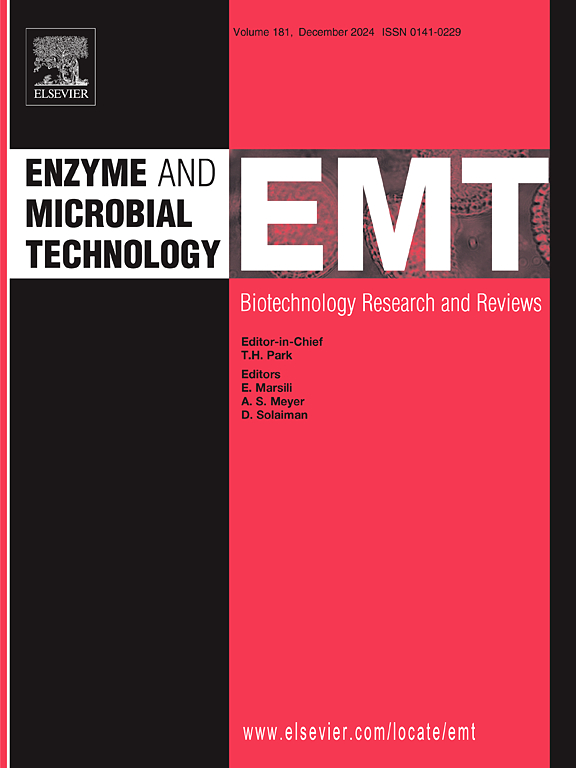Catalytic tunnel engineering of thermostable endoglucanase of GH7 family (W356C) from Aspergillus fumigatus gains catalytic rate
IF 3.7
3区 生物学
Q2 BIOTECHNOLOGY & APPLIED MICROBIOLOGY
引用次数: 0
Abstract
Tunnel engineering targets the access tunnels in enzymes, which is crucial for substrate binding and product release. Modifying the tunnels can lead to better biomass-degrading abilities of the lignocellulolytic enzymes. In this report, we have engineered the thermostable GH7 family endoglucanase from Aspergillus fumigatus (AfEgl7). The residues in the open tunnel having the highest bottleneck radius are mutated. Mutations are created (T229F, W356C) in the non-conserved region. The mutant W356C showed a 2-fold increase in product release rate (Vmax = 375.8 µM/min) and 2.5-fold higher catalytic activity (Kcat = 75.1 min−1) compared to wild-type (Vmax= 232 µM/min; Kcat = 30.9 min−1) using CM cellulose as substrate. The mutant T229F lost both catalytic activity and thermostability. Molecular dynamic simulations and docking studies of W356C revealed a change in structure near the product exit region, which may facilitate faster product release and account for the increased catalytic efficiency of the mutant. This study showed how redesigning the access pathways can be a promising strategy for protein engineering and de novo protein design by tailoring the open tunnel geometry to a ligand-specific manner.
烟曲霉GH7家族耐热内切葡聚糖酶(W356C)的催化隧道工程获得了催化速率
通道工程的目标是酶的通道,这对底物结合和产物释放至关重要。对通道进行修饰可以提高木质纤维素水解酶的生物量降解能力。在本报告中,我们从烟曲霉(Aspergillus fumigatus, AfEgl7)中设计了耐热GH7家族内切葡聚糖酶。坑道中瓶颈半径最大的残基发生突变。突变发生在非保守区域(T229F, W356C)。突变体W356C的产物释放率(Vmax= 375.8 µM/min)增加了2倍,催化活性(Kcat = 75.1 min−1)比野生型(Vmax= 232 µM/min;Kcat = 30.9 min−1),以CM纤维素为底物。突变体T229F失去了催化活性和热稳定性。W356C的分子动力学模拟和对接研究表明,在产物出口区附近的结构发生了变化,这可能有助于更快的产物释放,并解释了突变体催化效率的提高。这项研究表明,通过将开放通道的几何形状调整为配体特异性的方式,重新设计通路如何成为蛋白质工程和从头蛋白质设计的一种有前途的策略。
本文章由计算机程序翻译,如有差异,请以英文原文为准。
求助全文
约1分钟内获得全文
求助全文
来源期刊

Enzyme and Microbial Technology
生物-生物工程与应用微生物
CiteScore
7.60
自引率
5.90%
发文量
142
审稿时长
38 days
期刊介绍:
Enzyme and Microbial Technology is an international, peer-reviewed journal publishing original research and reviews, of biotechnological significance and novelty, on basic and applied aspects of the science and technology of processes involving the use of enzymes, micro-organisms, animal cells and plant cells.
We especially encourage submissions on:
Biocatalysis and the use of Directed Evolution in Synthetic Biology and Biotechnology
Biotechnological Production of New Bioactive Molecules, Biomaterials, Biopharmaceuticals, and Biofuels
New Imaging Techniques and Biosensors, especially as applicable to Healthcare and Systems Biology
New Biotechnological Approaches in Genomics, Proteomics and Metabolomics
Metabolic Engineering, Biomolecular Engineering and Nanobiotechnology
Manuscripts which report isolation, purification, immobilization or utilization of organisms or enzymes which are already well-described in the literature are not suitable for publication in EMT, unless their primary purpose is to report significant new findings or approaches which are of broad biotechnological importance. Similarly, manuscripts which report optimization studies on well-established processes are inappropriate. EMT does not accept papers dealing with mathematical modeling unless they report significant, new experimental data.
 求助内容:
求助内容: 应助结果提醒方式:
应助结果提醒方式:


